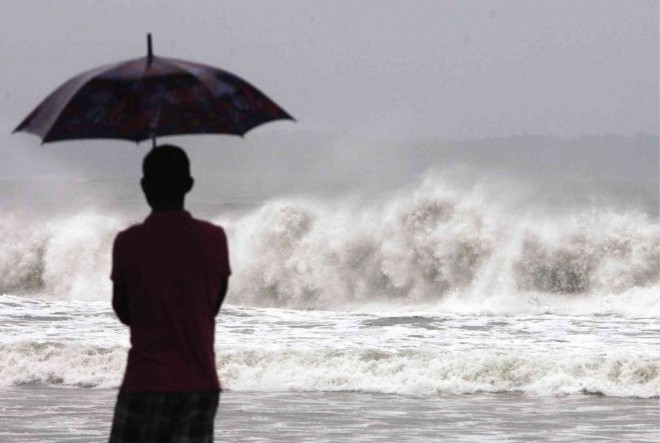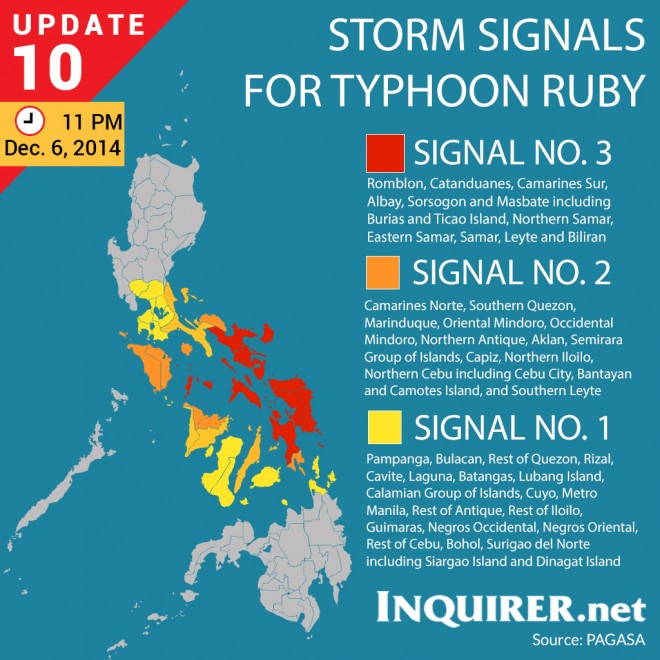‘Ruby’ slams into Samar

WAITING FOR ‘RUBY’ An anxious resident of Borongan City, Eastern Samar province, watches large waves slam into the shore as Eastern Visayas braces for the landfall of Typhoon “Ruby” in the area on Saturday. The country’s strongest typhoon this year made landfall hours later in Dolores town. RAFFY LERMA
More than 600,000 people huddled in temporary shelters in the Visayas and Bicol regions—one of the world’s biggest peacetime evacuations—as Typhoon “Ruby” (international name: Hagupit) smashed into Eastern Samar province on Saturday night.
Ruby, slightly weakened but moving faster, made landfall at Dolores town in Eastern Samar at 9:15 p.m. with cyclone-force winds of 175 kilometers per hour.
Heavy damage was expected as the storm moved west toward its next expected landfall, the island-province of Masbate, where it was expected to come ashore between 2 p.m. and 4 p.m. on Sunday and blow toward a third landfall on Sibuyan Island in Romblon province, where it was forecast to arrive between 8 p.m. and 10 p.m.
Ruby was forecast to make a fourth landfall on Tablas Island in Romblon between 2 a.m. and 4 a.m. on Monday.
From Tablas, the storm was forecast to make a fifth landfall in Oriental Mindoro province between 11 a.m. and 2 p.m. on Monday before blowing out into the West Philippine Sea.
The Philippine Atmospheric, Geophysical and Astronomical Services Administration (Pagasa) said it expected Ruby to clear the country by Tuesday.
Pagasa said that if Ruby continued on its present track, its eye would come nearest to Metro Manila at 110 kilometers on Monday afternoon or evening.
“Its effects would be felt as early as Sunday in Metro Manila because of [its] outer rain bands,” Pagasa weather specialist Chris Perez said.
He said Ruby’s effects on the capital would start with occasional rains, winds slightly picking up and then progress to moderate to heavy rains as the storm’s eye drew near.
Public storm warning signals may have been already hoisted over the metropolis by then, Perez said.
Ruby may weaken further
Pagasa raised the possibility of Ruby weakening further because of the surging northeast monsoon, but advised the public not to let down its guard as the storm would still be destructive.
Ruby slightly weakened as it drew near land on Saturday morning, with maximum sustained winds of 185 kph (down from 195 kph on Friday night) and gusts of up to 220 kph (down from 230 kph), moving west at 13 kph.
As of 4 p.m. on Saturday, Ruby was bearing down on Dolores with maximum sustained winds of 175 kph and gusts of 210 kph, but picked up speed, moving west at 16 kph.
According to Perez, the typhoon’s intensity was affected by the strong northeast monsoon caused by high pressure over mainland China.
The northeast monsoon is locally known as “amihan.”
“The amihan’s cold and dry winds are affecting the circulation of the typhoon. A cyclone thrives on warm and moist air,” Perez said.
He said the change of speed was dictated by high pressure northeast and northwest of Ruby.
If Ruby changes track, it may slightly move north or south, deviating from its path by 100 km from its projected movement.
Ruby’s faster movement cut its earlier projected crossing of central Philippines by one day.
On Friday, with Ruby moving at 13 kph, Pagasa said it would take the typhoon four days to cross the central islands, clearing the country as late as Wednesday.
Storm warning signals up
As Ruby neared land on Saturday, Pagasa raised Public Storm Signal No. 3 over the provinces of Catanduanes, Albay (including Burias Island), Sorsogon, Masbate (including Ticao Island), Northern Samar, Eastern Samar, Samar and Biliran, where winds of 101 kph to 185 kph and storm surges of up to 4.5 meters were expected.
Public Storm Signal No. 2 was hoisted over the provinces of Camarines Sur, Romblon, Aklan, Capiz, Northern Cebu (including Cebu City), Bantayan Island, Leyte and Southern Leyte, where winds of 61 kph to 100 kph were expected. Storm surges of up to 3 meters were also expected in these areas.
Public Storm Signal No. 1 was raised over the provinces of Southern Quezon, Camarines Norte, Marinduque, Batangas, Occidental Mindoro, Oriental Mindoro, Antique, Iloilo, Guimaras, Northern Negros, the rest of Cebu and Bohol, Surigao del Norte (including Siargao Island) and Dinagat, where winds were expected to pick up from 30 kph to 60 kph.
In areas under Signal No. 3 and No. 2, Pagasa alerted residents to flash floods and landslides.
Air and sea travel were suspended in the regions in the path of the typhoon.
The approach of Ruby triggered the evacuation of 600,000 people in Bicol and in Eastern Visayas, a region still battling to recover from devastation caused by Supertyphoon “Yolanda” (international name: Haiyan) 13 months ago.
Military mobilized
Alexander Pama, executive director of the National Disaster Risk Reduction and Management Council, said the agency had mobilized the entire Armed Forces of the Philippines to provide muscle in responding to Ruby.
Pama said the mobilization of the military would ensure that logistics get to where they were needed and that order was maintained.
AFP Chief of Staff Gen. Gregorio Pio Catapang gave assurance that the troops would be deployed as soon as the planes reached Eastern Samar.
Should a state of national calamity be declared, a multinational coordinating center will be set up at AFP General Headquarters in Camp Aguinaldo in Quezon City to ensure that there is an orderly and systematic gathering of aid for the typhoon victims, Catapang said.
‘There will be no looting’
The military chief called on traders in the areas in the typhoon’s path to keep their stores, particularly those selling basic goods, open.
“No looting will happen,” Catapang promised. “We will secure business establishments so goods and services can move around.”
To the public, Catapang said: “Relief goods will be coming as soon as the weather permits so there is no need for looting.”
The Department of Social Welfare and Development has set up a relief repacking hub in Cebu City.
In Albay province in Bicol, the evacuation of 563,198 people living in vulnerable communities was completed before sundown on Saturday.
Cedric Daep, head of the provincial Public Safety and Emergency Management Office, said the evacuees lived in communities vulnerable to lahar flows from Mayon Volcano, landslides and storm surges.
Gov. Joey Salceda has placed Albay under a state of calamity to free P15 million in calamity funds for use in responding to Ruby.
Ruby began to be felt in Eastern Visayas on Saturday morning. Strong winds and heavy rains brought by the typhoon disrupted the power supply in Northern and Eastern Samar in the morning.
In Tacloban City, Leyte province, streets were deserted as residents, scared of a repeat of the tragedy brought by Yolanda on Nov. 8 last year, stayed indoors.
Only soldiers and policemen could be seen roaming the city to prevent a repeat of the looting that happened there a day after Yolanda struck.
Praying for deliverance
Some families in the evacuation centers monitored the approach of the typhoon on radios. Others prayed, asking God to spare the city from another tragedy.
“We cannot do anything but pray and ask the Lord for His intervention. We can do nothing but pray,” said Dina Villanueva, 24, a mother of two children.
In Calbayog City, Samar, businesses closed their doors, while buses, ambulances, fire trucks and dump trucks stood ready to respond to emergencies in front of City Hall.
According to the city disaster council, 946 families from coastal villages had been evacuated to schools, churches, chapels and even private homes in the city.
Calbayog is located on the northern tip of Samar, on the border with Northern Samar, which is in the path of Ruby.
Several towns in Leyte, Samar, Biliran and Northern Samar evacuated people living in coastal communities in anticipation of Ruby.
Gov. Jose Ong of Northern Samar directed the mayors of towns facing the Pacific Ocean to evacuate the residents. He said 18,578 families, or 92,890 people, across the province had been moved to safe places.
Lack of evacuation centers
“Our main concern right now is that our municipalities lack evacuation centers that can stand a strong typhoon like Ruby,” Valente Bajet, provincial director of the Department of the Interior and Local Government (DILG), said.
He said the evacuees were given temporary shelter at municipal halls, churches and school buildings.
“We also encouraged private houses, especially if these are two-story houses and made of strong materials, to allow other families to take temporary shelter,” he said.
In the northern town of Daanbantayan, in Cebu province, the lack of evacuation centers prompted the municipal government to ask homeowners to open their houses to evacuees.
Municipal social welfare officer Heide Aplece said 436 homes accepted evacuees.
Fear of storm surge
Military and police officials said the number of evacuees in Masbate, Sorsogon and Catanduanes rose to nearly 4,000 families as of Saturday afternoon since they started the evacuations on Thursday.
Police Officer 3 Zandro Cabintoy, spokesperson for the Masbate provincial police, said residents of the island province became worried when they learned through television and newspaper reports that Masbate had been counted among the areas vulnerable to storm surges.
It was the first time for the residents to hear of a storm surge alert, Cabintoy said.
In Oriental and Occidental Mindoro, prayer text brigades from both residents and government officials were storming heaven, asking God to spare the island from Typhoon Ruby. With reports from Ma. April Mier, Michael Jaucian, Shiena Barrameda, Fernan Gianan, Juan Escandor and Madonna Virola, Inquirer Southern Luzon; Jennifer Allegado, Joey A. Gabieta, Jani Arnaiz, Carmel Lois Matus, Nestor P. Burgos Jr. and Doris C. Bongcac, Inquirer Visayas; AP
RELATED STORIES
Typhoon Ruby makes first landfall in Dolores, Eastern Samar—Pagasa
Signal No. 1 up in Metro Manila, 7 Luzon provinces as ‘Ruby’ heads to Masbate—Pagasa
Ruby’s effects felt; 600,000 flee
















